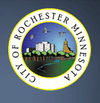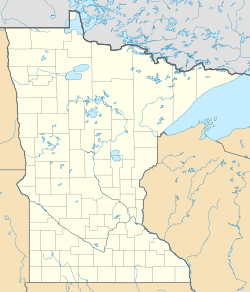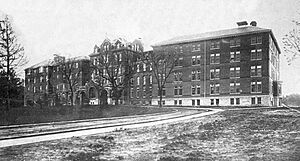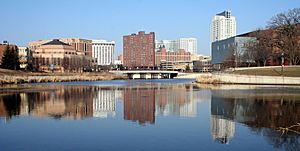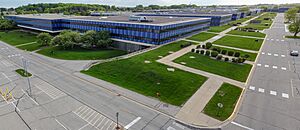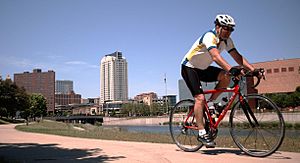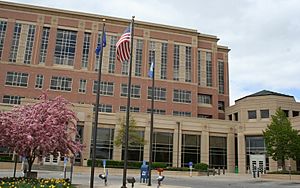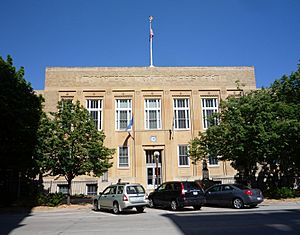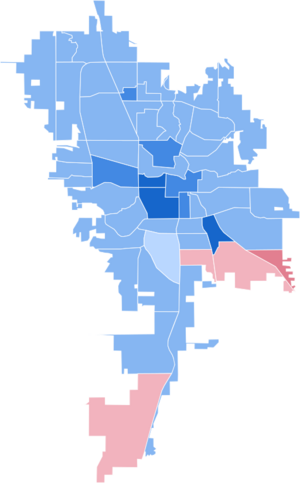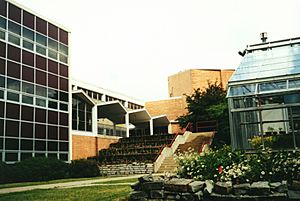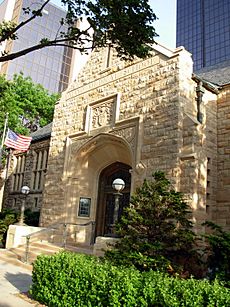Rochester, Minnesota facts for kids
Quick facts for kids
Rochester
|
|||
|---|---|---|---|
|
Downtown Rochester
Dr. William J. Mayo House
Mayo Clinic: Gonda and Plummer Buildings
Rochester Public Library
Rochester Technology Campus
|
|||
|
|||
| Nickname(s):
Med City, Roch
|
|||
| Motto(s):
America's City of Care and Innovation
|
|||
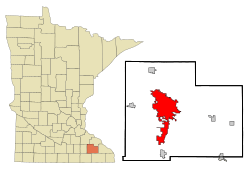
Location within Olmsted County, Minnesota
|
|||
| Country | United States | ||
| State | Minnesota | ||
| County | Olmsted | ||
| Founded | July 12, 1854 | ||
| Incorporated | August 5, 1858 | ||
| Area | |||
| • City | 55.87 sq mi (144.71 km2) | ||
| • Land | 55.58 sq mi (143.96 km2) | ||
| • Water | 0.29 sq mi (0.75 km2) | ||
| Elevation | 1,129 ft (344 m) | ||
| Population
(2020)
|
|||
| • City | 121,395 | ||
| • Estimate
(2023)
|
122,413 | ||
| • Rank | 234th in the United States 3rd in Minnesota |
||
| • Density | 2,184.07/sq mi (843.27/km2) | ||
| • Urban | 121,587 (273rd) | ||
| • Metro | 228,073 (207th) | ||
| Time zone | UTC-6 (Central (CST)) | ||
| • Summer (DST) | UTC-5 (CDT) | ||
| ZIP codes |
55901–55906
|
||
| Area code(s) | 507, 924 | ||
| FIPS code | 27-54880 | ||
| GNIS feature ID | 2396395 | ||
Rochester is a city in Olmsted County, Minnesota, United States. It is the county seat, which means it is the main city where the county government is located. Rochester sits among rolling hills along the Zumbro River in Southeast Minnesota.
It is the third-largest city in Minnesota. In 2020, about 121,395 people lived there. The larger Rochester area, including nearby towns, has around 230,000 residents. Rochester is famous as the home and birthplace of the Mayo Clinic, a world-renowned medical center.
Rochester started as a stop for stagecoaches traveling between Dubuque, Iowa, and Saint Paul, Minnesota. After the Mayo Clinic began in 1864, Rochester grew into a major center for healthcare. It also became important for farming in the region. For higher education, the city has the University of Minnesota Rochester, Rochester Community and Technical College, and the Mayo Clinic Alix School of Medicine.
Contents
History of Rochester
Long ago, different Native American groups like the Dakota, Ojibway, and Ho-Chunk lived in the Rochester area. The city was founded in 1854 by George Head and his wife, Henrietta. They built a log cabin called Head's Tavern. George Head named the new community after his hometown, Rochester, New York.
The city grew because it was a popular stop for stagecoaches. These coaches traveled along the Zumbro River on a route connecting Dubuque, Iowa, and Saint Paul, Minnesota. When the Winona and St. Peter Railroad started service in 1864, more people and businesses came, helping the city grow even faster.
In 1863, William W. Mayo arrived in Rochester. He was a surgeon checking draftees for the Civil War. A big tornado hit Rochester in 1883, destroying much of the city. It killed 37 people and injured about 200. Since there was no hospital nearby, Dr. Mayo and his two sons worked together to help the injured. People donated money, and with the help of the Sisters of St. Francis, a new hospital called St. Marys Hospital opened in 1889.
Rochester's Geography
Rochester is located along the South Fork of the Zumbro River, which is about 57.6 miles (92.7 km) long. The city is surrounded by gentle hills and farmland. It is part of a deciduous forest area. The Zumbro Watershed covers 1,422 square miles (3,683 km2) of farms and city areas.
Rochester is in southeast Minnesota, at the edge of the Driftless Area. This special region was never covered by glaciers. Because of this, it has deep river valleys and rugged land. The United States Census Bureau says Rochester covers about 54.75 square miles (141.80 km2). Most of this is land, with a small amount of water. The city is about 85 miles (137 km) southeast of Minneapolis–Saint Paul.
Olmsted County, where Rochester is, is one of only four counties in Minnesota without a natural lake. However, there are artificial lakes like Silver Lake. This lake was created by damming a part of the Zumbro River. Silver Lake used to be a cooling pond for a power plant. The warm water from the plant kept the lake from freezing in winter. This attracted many migrating Canada geese. Many crows also gather in Rochester during winter.
Rochester has a large system of parks. The biggest ones are Silver Lake and Soldiers Field, located in the city center. A major flood in 1978 led the city to build a successful flood-control system. This project changed many nearby rivers and streams. The Zumbro River, which flows through downtown, is now being improved for more development and public use.
Rochester's Climate
Rochester has a warm-summer humid continental climate. This means it has four clear seasons. Summers are warm, and winters are cold. Rochester gets about 33.02 inches (839 mm) of rain and 51.9 inches (132 cm) of snow each year. Heavy snow is common in winter. Spring and fall are changing seasons, with temperatures getting warmer in spring and cooler in fall. Sometimes, it can snow in early spring or late fall.
Rochester is known as one of the windiest cities in the United States. Wind speeds average 12.6 mph (20.3 kph). The windiest months are usually from January to April. Rochester has been hit by two strong tornadoes since 1950. One hit in 2010, damaging homes and businesses. Another tornado struck in 2019, causing damage in Southwest Rochester.
| Climate data for Rochester International Airport, Minnesota (1991–2020 normals, extremes 1886–present) | |||||||||||||
|---|---|---|---|---|---|---|---|---|---|---|---|---|---|
| Month | Jan | Feb | Mar | Apr | May | Jun | Jul | Aug | Sep | Oct | Nov | Dec | Year |
| Record high °F (°C) | 58 (14) |
63 (17) |
82 (28) |
92 (33) |
106 (41) |
105 (41) |
108 (42) |
100 (38) |
100 (38) |
93 (34) |
77 (25) |
64 (18) |
108 (42) |
| Mean maximum °F (°C) | 40.9 (4.9) |
44.1 (6.7) |
62.3 (16.8) |
79.0 (26.1) |
87.3 (30.7) |
90.7 (32.6) |
89.7 (32.1) |
87.5 (30.8) |
86.1 (30.1) |
79.9 (26.6) |
62.8 (17.1) |
45.3 (7.4) |
93.0 (33.9) |
| Mean daily maximum °F (°C) | 22.5 (−5.3) |
26.7 (−2.9) |
39.9 (4.4) |
55.3 (12.9) |
68.0 (20.0) |
77.6 (25.3) |
80.3 (26.8) |
78.0 (25.6) |
71.8 (22.1) |
57.9 (14.4) |
41.7 (5.4) |
28.0 (−2.2) |
54.0 (12.2) |
| Daily mean °F (°C) | 14.7 (−9.6) |
18.7 (−7.4) |
31.7 (−0.2) |
45.2 (7.3) |
57.6 (14.2) |
67.5 (19.7) |
70.5 (21.4) |
68.2 (20.1) |
61.1 (16.2) |
47.9 (8.8) |
33.6 (0.9) |
20.8 (−6.2) |
44.8 (7.1) |
| Mean daily minimum °F (°C) | 7.0 (−13.9) |
10.7 (−11.8) |
23.4 (−4.8) |
35.1 (1.7) |
47.1 (8.4) |
57.5 (14.2) |
60.8 (16.0) |
58.3 (14.6) |
50.4 (10.2) |
38.0 (3.3) |
25.6 (−3.6) |
13.6 (−10.2) |
35.6 (2.0) |
| Mean minimum °F (°C) | −16.6 (−27.0) |
−11.1 (−23.9) |
−0.7 (−18.2) |
20.0 (−6.7) |
33.3 (0.7) |
45.2 (7.3) |
50.5 (10.3) |
48.4 (9.1) |
35.4 (1.9) |
22.0 (−5.6) |
7.0 (−13.9) |
−9.8 (−23.2) |
−19.6 (−28.7) |
| Record low °F (°C) | −42 (−41) |
−35 (−37) |
−31 (−35) |
5 (−15) |
21 (−6) |
31 (−1) |
40 (4) |
32 (0) |
22 (−6) |
−6 (−21) |
−24 (−31) |
−33 (−36) |
−42 (−41) |
| Average precipitation inches (mm) | 0.99 (25) |
1.02 (26) |
2.02 (51) |
3.52 (89) |
4.35 (110) |
5.35 (136) |
4.19 (106) |
4.12 (105) |
3.60 (91) |
2.43 (62) |
1.80 (46) |
1.28 (33) |
34.67 (881) |
| Average snowfall inches (cm) | 12.2 (31) |
10.7 (27) |
8.6 (22) |
3.3 (8.4) |
0.5 (1.3) |
0.0 (0.0) |
0.0 (0.0) |
0.0 (0.0) |
0.0 (0.0) |
0.9 (2.3) |
4.5 (11) |
12.4 (31) |
53.1 (135) |
| Average precipitation days (≥ 0.01 in) | 9.4 | 8.0 | 10.2 | 12.2 | 13.3 | 12.5 | 10.5 | 10.0 | 9.3 | 9.5 | 9.2 | 9.6 | 123.7 |
| Average snowy days (≥ 0.1 in) | 8.8 | 7.3 | 5.6 | 2.6 | 0.1 | 0.0 | 0.0 | 0.0 | 0.0 | 0.8 | 4.5 | 8.7 | 38.4 |
| Average relative humidity (%) | 76.6 | 76.1 | 74.8 | 68.3 | 66.8 | 68.9 | 72.2 | 74.6 | 75.2 | 71.5 | 77.4 | 80.0 | 73.5 |
| Average dew point °F (°C) | 5.9 (−14.5) |
10.9 (−11.7) |
22.5 (−5.3) |
33.4 (0.8) |
44.6 (7.0) |
54.9 (12.7) |
60.4 (15.8) |
58.5 (14.7) |
50.2 (10.1) |
37.9 (3.3) |
25.9 (−3.4) |
12.6 (−10.8) |
34.8 (1.6) |
| Source: NOAA (relative humidity and dew point 1961–1990) | |||||||||||||
- Notes
Rochester's Population and People
| Historical population | |||
|---|---|---|---|
| Census | Pop. | %± | |
| 1860 | 1,424 | — | |
| 1870 | 3,953 | 177.6% | |
| 1880 | 5,103 | 29.1% | |
| 1890 | 5,321 | 4.3% | |
| 1900 | 6,843 | 28.6% | |
| 1910 | 7,844 | 14.6% | |
| 1920 | 13,722 | 74.9% | |
| 1930 | 20,621 | 50.3% | |
| 1940 | 28,312 | 37.3% | |
| 1950 | 29,885 | 5.6% | |
| 1960 | 40,663 | 36.1% | |
| 1970 | 53,766 | 32.2% | |
| 1980 | 57,890 | 7.7% | |
| 1990 | 70,745 | 22.2% | |
| 2000 | 85,806 | 21.3% | |
| 2010 | 106,769 | 24.4% | |
| 2020 | 121,395 | 13.7% | |
| 2023 (est.) | 122,413 | 14.7% | |
| U.S. Decennial Census 2020 Census |
|||
According to the 2020 census, Rochester had a population of 121,395 people. This means there were about 2,187.5 people per square mile (844.6 per km2). The city had 53,210 homes.
The people in Rochester come from many different backgrounds. In 2020, 73.2% of residents were White. About 8.9% were Black or African American, and 7.9% were Asian. A small number were Native American or Pacific Islander. About 6.6% of the population identified as Hispanic or Latino.
Many people in Rochester have German American roots, making up 35.5% of the population. Norwegian Americans are 15.9%, and Irish Americans are 11.6%. The city also has growing communities, including people of Hmong descent.
In 2022, there were 43,025 households in Rochester. About 31.9% of these households had children under 18 living there. The average household had 2.42 people. The average family had 3.04 people. The median age in the city was 35 years old. About 24.8% of residents were under 18.
| Race / Ethnicity (NH = Non-Hispanic) | Pop 2000 | Pop 2010 | Pop 2020 | % 2000 | % 2010 | % 2020 |
|---|---|---|---|---|---|---|
| White alone (NH) | 73,656 | 84,608 | 87,180 | 85.84% | 79.24% | 71.82% |
| Black or African American alone (NH) | 3,034 | 6,586 | 10,661 | 3.54% | 6.17% | 8.78% |
| Native American or Alaska Native alone (NH) | 232 | 251 | 323 | 0.27% | 0.24% | 0.27% |
| Asian alone (NH) | 4,796 | 7,212 | 9,469 | 5.59% | 6.76% | 7.80% |
| Pacific Islander alone (NH) | 32 | 38 | 56 | 0.04% | 0.04% | 0.05% |
| Some Other Race alone (NH) | 103 | 212 | 429 | 0.12% | 0.20% | 0.35% |
| Mixed Race or Multi-Racial (NH) | 1,388 | 2,354 | 5,293 | 1.62% | 2.21% | 4.36% |
| Hispanic or Latino (any race) | 2,565 | 5,508 | 7,984 | 2.99% | 5.16% | 6.58% |
| Total | 85,806 | 106,769 | 121,395 | 100.00% | 100.00% | 100.00% |
Rochester's Economy
Mayo Clinic is the most important part of Rochester's economy. As of 2016, it employed 51,000 people. It also brings over 2 million visitors to the city every year. The clinic's many buildings, along with hotels, restaurants, and shops, make up most of downtown Rochester. The Mayo Clinic is the largest employer in Minnesota, not counting the state government. Other healthcare providers, like the Rochester Federal Medical Center, also employ many people.
The Rochester Technology Campus is a huge facility. It covers 2.56 million square feet. This campus has offices, manufacturing areas, warehouses, data centers, and labs. It has been home to several technology companies. IBM designed and made its midrange computers here. The first Blue Gene supercomputer prototype was also built here. This campus also helped create servers for the Roadrunner supercomputer.
Rochester's economy is also shaped by farming in the area. Many dairy farms operate nearby. Also, Kerry Flavours and Ingredients, a part of the global company Kerry Group, has a factory in Rochester. This factory makes fermented ingredients used in foods like breads and meats.
| No. | Employer | No. of Employees |
|---|---|---|
| 1 | Mayo Clinic | 51,000 |
| 2 | Rochester Public Schools | 2,872 |
| 3 | IBM | 2,791 |
| 4 | Olmsted County | 1,371 |
| 5 | Olmsted Medical Center | 1,321 |
| 6 | City of Rochester | 1,166 |
| 7 | McNeilus Truck & Manuf. | 791 |
| 8 | Benchmark Electronics | 625 |
| 9 | Spectrum | 577 |
| 10 | Rochester Community and Technical College | 492 |
| 11 | McNeilus Steel, Inc. | 490 |
| 12 | Federal Medical Center, Rochester | 452 |
| 13 | Crenlo | 450 |
| 14 | Cardinal of Minnesota | 425 |
| 15 | Reichel Foods | 423 |
| 16 | Geotek | 417 |
| 17 | Halcon | 400 |
Destination Medical Center Project
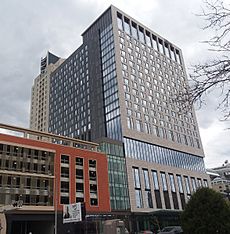
In 2013, Governor Mark Dayton signed a bill called Destination Medical Center (DMC). This plan aims to boost Minnesota's economy and business growth. Because of this law, the Mayo Clinic invested $3.5 billion. This money was used to improve patient rooms, add more workspaces, and build new research and office buildings.
The main parts of this plan are in different areas of the city. The Downtown Waterfront area includes the Government Center and Civic Center. It also covers most areas near the Zumbro River. The Central Station area includes Central Park. It aims to become a main transportation hub for the city. St. Marys Place covers St. Marys Hospital and St. Marys Park. The Heart of the City features the Mayo Clinic campus. It also has major housing, business, and shopping companies. The Discovery Square area has facilities for science and technology research. Finally, the UMR and Recreation area includes Soldiers Field and the University of Minnesota Rochester campus.
Arts and Culture in Rochester
Several buildings in Rochester are listed on the National Register of Historic Places. These include the old Chateau Theatre, which the city bought in 2015 to protect it. Avalon Music is another historic building. It was once a hotel important to the local civil rights movement. After being renovated, the Chateau Theatre reopened in 2019 as a place for exhibitions.
The Rochester Art Center, founded in 1946, is located downtown. It is just south of the Mayo Civic Center. In 2017, the Art Center faced financial challenges. This brought attention to the need for more art spaces in the city.
During the summer, from June to August, the city hosts "Thursdays Downtown." Local restaurants and artists set up booths along First Avenue downtown. There are two stages where bands perform. You can also find street musicians playing music.
The Rochester Symphony Orchestra & Chorale is the oldest arts group in the community. It started in 1919 as the Rochester Orchestra. Its first group, the Lawler-Dodge Orchestra, began in 1912. It was a volunteer orchestra led by Daisy Plummer, wife of Mayo Clinic doctor Dr. Henry Plummer. In its early days, the Orchestra played music for silent movies at the old Chateau Theatre.
The Gray Duck Theater, an independent movie theater, opened in 2019. Rochester also has the Rochester Public Library near the Civic Center. It is one of the largest libraries in the area. In 2018, it won the National Medal for Museum and Library Service.
Sports in Rochester
| Team | League | Venue |
|---|---|---|
| Rochester Honkers | Northwoods League, Baseball | Mayo Field |
| Rochester Grizzlies | NA3HL, Ice Hockey | Rochester Recreation Center |
| Med City Freeze | Southern Plains Football League, Semi-Pro Football | Rochester Regional Stadium |
| Rochester Med City FC | National Premier Soccer League, Soccer | Rochester Regional Stadium at Rochester Community and Technical College |
Parks and Recreation
Rochester's city park system has over 100 locations. These parks cover about 5 square miles (13 km2). Many parks are along Bear Creek and the South Fork Zumbro rivers. The city also has 85 miles (137 km) of paved trails for walking and biking.
The city manages four public golf courses: Northern Hills, Eastwood Golf Club, Hadley Creek, and Soldiers Field Golf Course. There are also private golf courses in the Rochester area. These include Willow Creek Golf Club and Oak Summit Golf Club. Rochester has also started a bike share program. Members and visitors can rent bikes for free from locations like the Rochester Public Library.
Quarry Hill Park
Quarry Hill Park has an interesting history. It started in 1875 as part of the Minnesota Inebriate Asylum. Land was bought in 1876, and construction began in 1877. This included a hospital and a park for patients and their families. In 1965, the park was given to the state for public use. Since then, many improvements have been made, including paved trails.
The 329-acre (133 ha) park has over 8 miles (13 km) of paved and hiking trails. It also has a pond and a historic sandstone cave. This soft cave was dug in 1882 to store food for the state hospital patients. The cave was later abandoned when modern refrigerators were invented. Now, it is a historic site.
Quarry Hill Nature Center is the main part of Quarry Hill Park. The Nature Center opened in 1973 and was made bigger in 1990. In 2017, new facilities for nordic skiing were added. These facilities include modern classrooms. There is also a 19th-century prairie-style home where you can rent skis and snowshoes.
Government and Politics
Rochester is run by a mayor-council government. This means it has a mayor and a seven-member city council. The current mayor is Kim Norton. As of July 2025, the city council members are: Randy Schubring (City Council President), Patrick Keane (1st Ward), Nick Miller (2nd Ward), Norman Wahl (3rd Ward), Andy Friederichs (4th Ward), Shaun Palmer (5th Ward), and Dan Doering (6th Ward).
All city elected offices in Rochester are non-partisan. This means candidates do not run as members of a political party.
Rochester is the main city of Olmsted County. The county is managed by a seven-member elected county board. Each member represents people from a specific district. County Commissioners serve a 4-year term. They can run for re-election if they want to. The County Attorney and County Sheriff are also elected for 4-year terms. They lead their offices and are responsible to the people of Olmsted County.
Rochester is part of the Olmsted County District Court. This court is within the Third Judicial District of Minnesota.
The city is in parts of Minnesota state legislative districts 25 and 26. In the Minnesota House of Representatives, District 25A is represented by Duane Quam (R). District 25B is represented by Andy Smith (DFL). District 26A is represented by Tina Liebling (DFL). District 26B is represented by Nels Pierson (R). In the Minnesota Senate, Rochester is represented by Liz Boldon (DFL) and Carla Nelson (R). Rochester is in Minnesota's 1st congressional district. This district is represented by Brad Finstad, a member of the Republican Party.
Rochester has been voting more for Democratic candidates in local and national elections. In the 2020 presidential election, President Joe Biden received almost 60% of the votes in the city. This was the highest number of votes for a Democratic candidate in Rochester's history.
| Year | Republican | Democratic | Third parties |
|---|---|---|---|
| 2024 | 37.8% 24,524 | 59.5% 38,588 | 2.7% 1,732 |
| 2020 | 38.2% 25,210 | 59.4% 39,202 | 2.4% 1,621 |
| 2016 | 39.8% 22,944 | 49.7% 28,611 | 10.5% 6,044 |
| 2012 | 44.1% 24,973 | 53.1% 30,093 | 2.8% 1,583 |
| 2008 | 44.4% 24,102 | 53.6% 29,038 | 2.0% 1,078 |
| 2004 | 50.0% 24,711 | 48.7% 24,041 | 1.3% 644 |
| 2000 | 49.9% 19,954 | 45.3% 18,123 | 4.8% 1,942 |
| 1996 | 44.2% 15,055 | 46.2% 15,716 | 9.6% 3,286 |
| 1992 | 41.8% 15,734 | 35.5% 13,348 | 22.7% 8,548 |
| 1988 | 57.9% 17,997 | 42.1% 13,064 | 0.0% 0 |
| 1984 | 62.1% 18,168 | 37.9% 11,066 | 0.0% 0 |
| 1980 | 54.0% 14,155 | 35.2% 9,210 | 10.8% 2,840 |
| 1976 | 62.5% 16,064 | 35.8% 9,196 | 1.7% 445 |
| 1972 | 69.7% 15,882 | 28.2% 6,419 | 2.1% 496 |
| 1968 | 55.3% 11,294 | 42.0% 8,571 | 2.7% 559 |
| 1964 | 45.4% 8,297 | 54.4% 9,945 | 0.2% 46 |
| 1960 | 60.9% 10,224 | 38.8% 6,521 | 0.3% 56 |
US House of Representatives
| Name | Congressional District | Assumed office | Party |
|---|---|---|---|
| Brad Finstad | 1st District | 2022 | Republican |
Minnesota Senate
| Name | District | Assumed office | Party |
|---|---|---|---|
| Carla Nelson | District 24 | 2011 | Republican |
| Liz Boldon | District 25 | 2023 | DFL |
Minnesota House of Representatives
| Name | District | Assumed office | Party |
|---|---|---|---|
| Duane Quam | District 24A | 2011 | Republican |
| Tina Liebling | District 24B | 2005 | DFL |
| Kim Hicks | District 25A | 2023 | DFL |
| Andy Smith | District 25B | 2023 | DFL |
Education in Rochester
Rochester Public Schools serve 16,300 students. There are 23 public elementary and secondary schools. The city has three public high schools: John Marshall, Mayo, and Century. Private schools include Lourdes, Schaeffer Academy, and Rochester Central Lutheran School. The Rochester STEM Academy opened in 2011.
For higher education, Rochester has several options. Rochester Community and Technical College shares a campus with a branch of Winona State University. The University of Minnesota Rochester was established downtown in 2007. Branches of Augsburg University and College of St. Scholastica are also in Rochester. The Mayo Clinic offers advanced medical education and research programs. These include the Mayo Clinic Alix School of Medicine and the Mayo Clinic Graduate School of Biomedical Sciences.
According to the 2011–2015 United States Census Bureau, 94.1% of people aged 25 and older had a high school diploma or higher. Also, 41.3% of people aged 25 and older had a bachelor's degree or higher.
Media in Rochester
The city's newspaper is the Post-Bulletin. It publishes Monday through Saturday afternoons. The Post-Bulletin company also publishes Rochester Magazine, a monthly magazine with feature stories.
Rochester has four television stations. KTTC channel 10.1 (NBC) and KXLT-TV channel 47 (Fox) share studios. ABC affiliate KAAL (channel 6) and CBS affiliate KIMT (channel 3) are also based in Rochester. Channel 15 KSMQ (PBS) in Austin and channel 24 KYIN (PBS) in Mason City also serve the area. KIMT opened a studio in Rochester in late 2017. This studio now serves as the main place for their newscasts.
Charter Communications provides cable service to the Rochester area. Metronet, a company from Indiana, is building a fiber-optic network to offer cable service in Rochester.
Transportation in Rochester
Rochester is served by three U.S. highways: U.S. 14, U.S. 52, and U.S. 63. The southern edge of Rochester is near Interstate 90 and State Highway 30. Olmsted County Highway 22 is also a main road in the city.
Many downtown buildings are connected by skyways and underground walkways. Residents often use these to avoid bad winter weather. Public bus service is run by Rochester Public Transit. The City of Rochester encourages biking with its many trails. All city buses have bike carriers to make it easy to transport bikes.
Rochester International Airport is about 7 miles (11 km) south of downtown. It is the second busiest commercial airport in Minnesota. It has direct flights to Atlanta, Chicago, Denver, and Minneapolis. Nonstop flights to Phoenix and Fort Myers began in early 2022.
Rochester has a shuttle service to the Minneapolis St. Paul International Airport. This service is provided by Rochester Shuttle Service and Groome Transportation.
Rochester's last passenger train service ended in 1963. The closest Amtrak station is in Winona, Minnesota, about 45 miles (72 km) to the east. Travelers can buy tickets from Amtrak for a shuttle bus. This bus connects with the daily Empire Builder train in La Crosse, Wisconsin.
Rochester is planning a 2.6-mile (4.2 km) bus rapid transit line called Link. This route will have seven stations along 2nd Street SW. It is expected to open in 2025. It will be the first bus rapid transit line in Minnesota outside the Twin Cities.
Major Highways in Rochester
 US 14 – U.S. Route 14
US 14 – U.S. Route 14 US 52 – U.S. Route 52
US 52 – U.S. Route 52 US 63 – U.S. Route 63
US 63 – U.S. Route 63 I-90 – Interstate 90
I-90 – Interstate 90 MN 30 – Minnesota State Highway 30
MN 30 – Minnesota State Highway 30
See also
 In Spanish: Rochester (Minnesota) para niños
In Spanish: Rochester (Minnesota) para niños









